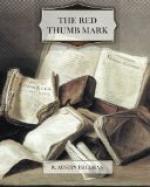“Ah, I thought we should see you here before long, doctor,” said he genially. “I heard this morning that you have this thumb-print case in hand.”
“Yes,” replied Thorndyke; “I am going to see what can be done for the defence.”
“Well,” said the officer as he ushered us into the building, “you’ve given us a good many surprises, but you’ll give us a bigger one if you can make anything of this. It’s a foregone conclusion, I should say.”
“My dear fellow,” said Thorndyke, “there is no such thing. You mean that there is a prima facie case against the accused.”
“Put it that way if you like,” replied the officer, with a sly smile, “but I think you will find this about the hardest nut you ever tried your teeth on—and they’re pretty strong teeth too, I’ll say that. You had better come into Mr. Singleton’s office,” and he conducted us along a corridor and into a large, barely-furnished room, where we found a sedate-looking gentleman seated at a large writing table.
“How-d’ye-do, doctor?” said the latter, rising and holding out his hand. “I can guess what you’ve come for. Want to see that thumb-print, eh?”
“Quite right,” answered Thorndyke, and then, having introduced me, he continued: “We were partners in the last game, but we are on opposite sides of the board this time.”
“Yes,” agreed Mr. Singleton; “and we are going to give you check-mate.”
He unlocked a drawer and drew forth a small portfolio, from which he extracted a piece of paper which he laid on the table. It appeared to be a sheet torn from a perforated memorandum block, and bore the pencilled inscription: “Handed in by Reuben at 7.3 p.m., 9.3.01. J. H.” At one end was a dark, glossy blood-stain, made by the falling of a good-sized drop, and this was smeared slightly, apparently by a finger or thumb having been pressed on it. Near to it were two or three smaller smears and a remarkably distinct and clean print of a thumb.
Thorndyke gazed intently at the paper for a minute or two, scrutinising the thumb-print and the smears in turn, but making no remark, while Mr. Singleton watched his impassive face with expectant curiosity.
“Not much difficulty in identifying that mark,” the official at length observed.
“No,” agreed Thorndyke; “it is an excellent impression and a very distinctive pattern, even without the scar.”
“Yes,” rejoined Mr. Singleton; “the scar makes it absolutely conclusive. You have a print with you, I suppose?”
“Yes,” replied Thorndyke, and he drew from a wide flap-pocket the enlarged photograph, at the sight of which Mr. Singleton’s face broadened into a smile.
“You don’t want to put on spectacles to look at that,” he remarked; “not that you gain anything by so much enlargement; three diameters is ample for studying the ridge-patterns. I see you have divided it up into numbered squares—not a bad plan; but ours—or rather Galton’s, for we borrowed the method from him—is better for this purpose.”




